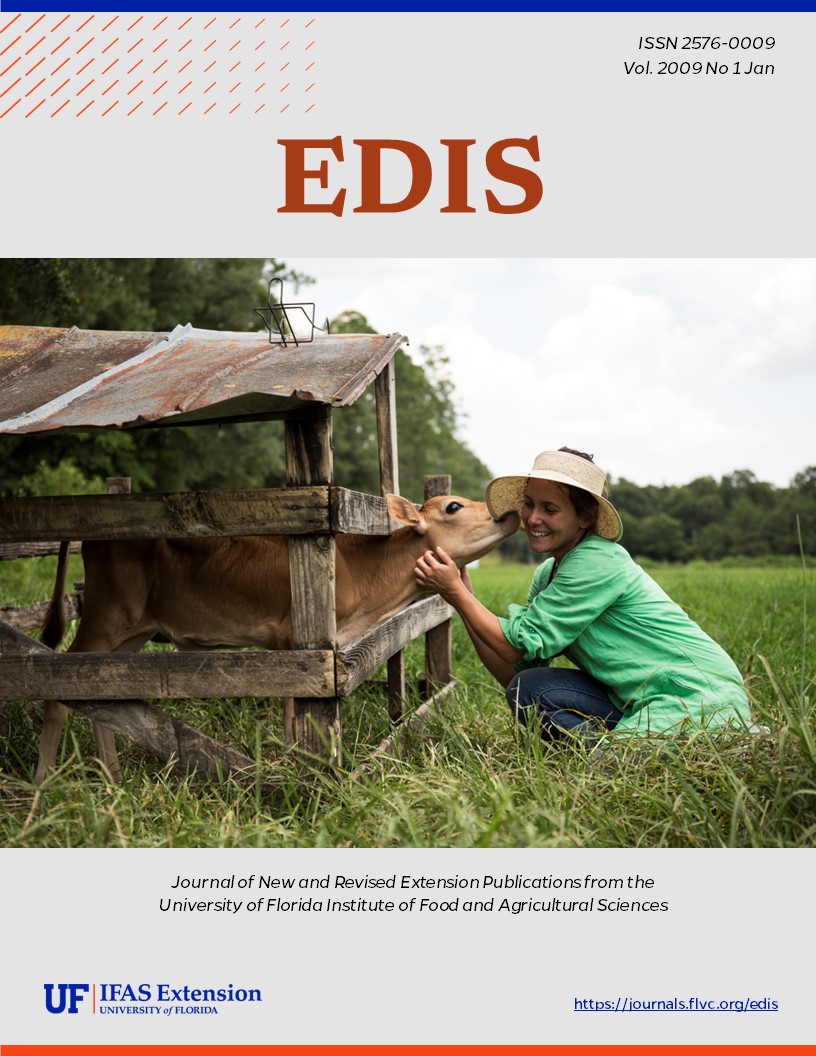Abstract
EENY-443, a 7-page fact sheet by Wai-Han Chan and Phillip E. Kaufman, is part of the Featured Creatures Collection. It describes this tick commonly found on dogs as an adult — its distribution, description, life cycle, seasonality, medical and veterinary importance, removal, and management. Includes references. Published by the UF Department of Entomology and Nematology, November 2008.
References
American Lyme Disease Foundation (ALDF). (2006). Rocky Mountain spotted fever. http://www.aldf.com/RMSF.shtml (23 September 2008).
Burg JG. 2001. Seasonal Activity and spatial distribution of host-seeking adults of the tick Dermacentor variabilis. Medical and Veterinary Entomology 15: 413-421. https://doi.org/10.1046/j.0269-283x.2001.00329.x
Campbel A. 1979. Ecology of the American dog tick, Dermacentor variabilis in southwestern Nova Scotia. Recent Advances in Acarology. Rodriguez JG (editor). Volume 2: 135-143. https://doi.org/10.1016/B978-0-12-592202-9.50022-7
Carroll JF, Nichols JD. 1986. Parasitization of meadow voles, Microtus pennsylvanicus (Ord), by American dog ticks, Dermacentor variabilis (Say), and adult tick movement during high host density. Journal of Entomological Science 21: 102-113. https://doi.org/10.18474/0749-8004-21.2.102
Clark County Health District Office of Epidemiology (CCHDOE). (2001, May 11). Tularemia. http://www.southernnevadahealthdistrict.org/physician/download/physician_tularemia.pdf (23 September 2008).
Conlon JM, Rockett CL. 1982. Ecological investigations of the American dog tick, Dermacentor variabilis (Say), in northwest Ohio (Acari: Ixodidae). International Journal of Acarology 8: 125-131. https://doi.org/10.1080/01647958208683290
Dame D, Fasulo TR. (2003). Public Health Pesticide Applicator Training Manual. http://vector.ifas.ufl.edu (23 September 2008).
Goddard J. 1996. Physician's Guide to Arthropods of Medical Importance. pp. 287-302. CRC Press. Jackson, Mississippi.
Gregson JD. 1973. Tick paralysis: an appraisal of natural and experimental data. Monograph No. 9. Canada Department of Agriculture, Ottawa.
Eddis J, Oyston CF, Green M, Titball RW. 2002. Tularemia. Clinical Microbiology Reviews: 15: 631-646. https://doi.org/10.1128/CMR.15.4.631-646.2002
Fasulo TR. (2002). Fleas and Ticks. Bug Tutorials http://pests.ifas.ufl.edu/software/det_bugs.htm. University of Florida/IFAS. CD-ROM. SW 159.
Fasulo TR, Kern W, Koehler PG, Short DE. (2005). Pests In and Around the Home http://pests.ifas.ufl.edu/software/det_pests.htm. Version 2.0. University of Florida/IFAS. CD-ROM. SW 126.
James M, Robert FH. 1969. Herm's Medical Entomology. 6th Edition. pp. 326-329. The Macmillan Company. Toronto, Ontario.
Koehler PG, Oi F. (2003). Ticks. EDIS. http://edis.ifas.ufl.edu/IG088 (23 September 2008).
Matheson R. 1950. Medical Entomology, 2nd Edition. Comstock Publishing Company, Inc. Ithaca, NY.
McEnroe WD. 1979a. Dermacentor variabilis (Say) in eastern Massachusetts. Recent Advances in Acarology. Rodriguez JG (editor). Volume 2: 145-153. https://doi.org/10.1016/B978-0-12-592202-9.50023-9
McEnroe, W.D. 1979b. The effect of the temperature regime on Dermacentor variabilis (Say) populations in eastern North America. Acarologia 20: 58-67.
Mcnemee RB, Sames WJ, Maloney Jr FA. 2003. Occurrence of Dermacentor variabilis (Acari:Ixodidae) around a porcupine (Rodentia: Erthethizontidae) carcass at Camp Ripley, Minnesota. Journal of Medical Entomology 40: 108-111. https://doi.org/10.1603/0022-2585-40.1.108
Newhouse VF. (1983) Variations in population density, movement, and rickettsial infection rates in a local population of Dermacentor variabilis (Acarina: Ixodidae) ticks in the piedmont of Georgia. Environmental Entomology 12: 1737-1746. https://doi.org/10.1093/ee/12.6.1737
Parsons GL, Rossignol PA. 1989. Identifying adult hard ticks commonly found on humans in Oregon. EM8410. Oregon State University Extension Service.
Piesman J, Gage KL. 1996. Ticks and mites and the agents they transmit. The Biology of Disease Vectors. Beaty BJ, Marquardt WC (editors). pp. 160-174. University Press of Colorado. Newot, CO.
Schmitt N. Bowner EJ, Gregson JD. 1969. Tick paralysis in British Columbia. Canadian Medical Association 100: 417-21.
Smith EH, Whitman RC. 1992. Field Guide to Structural Pests. National Pest Management Association, Dunn Loring, VA.
Sonenshine DE, Stout IJ. 1971. Ticks infesting medium-sized wild mammals in two forest localities in Virginia. Journal of Medical Entomology 8: 217-227. https://doi.org/10.1093/jmedent/8.3.217
Thorner AR, Walker D, Petri WA. 1998. Rocky Mountain Spotted Fever. Clinical Infectious Diseases by the Infectious Diseases Society of America. 27: 1353-1360. https://doi.org/10.1086/515037
U.S. Army Center for Health Promotion and Preventive Medicine (USACHPPM). 2003. Entomological Sciences Program. Aberdeen Proving Ground, MD 21010-5403.

